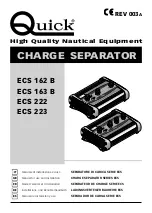
RF – Series User Manual
MKTF – 167-C
10
05/17
area to prevent immediate dulling of drill
bit.
3.
Remove everything from under the sink.
4.
Place newspaper or paper towels directly
under drilling location in order to catch the
drill shavings.
5.
Using the 1/4” (6mm) drill bit, drill a
centering or pilot hole in the center of the
desired faucet location. Note: this
centering/pilot hole will make it easier for
the 7/16" (11mm) drill bit to cut through the
sink. Operate the drill slowly and carefully
— especially when the drill bit is about to
penetrate the metal. Otherwise, damage to
sink may occur. Use lubricating oil to keep
the drill bit cool while drilling.
6.
Discard paper towels and newspaper used
in sink and below sink. Be very careful not
to drop any shavings in sink or on the floor
as they will oxidize and stain surfaces very
quickly.
7.
Using a variable speed (VS) drill with a
carbide grinding burr, gently grind away
enough porcelain or enamel to
accommodate the 7/16” (11mm) drill bit,
approximately the size of a dime. Enough
surface material must be removed to
expose the base metal.
HELPFUL HINT:
If you notice any rust
spots from dropped shavings you should be
able to get rid of them by scrubbing them
with a cleaning chemical.
8.
Cover the drilled hole with your finger.
BE
VERY CAREFUL NOT TO CUT
YOURSELF ON SHARP EDGES!
Rinse
sink then scrub with cleaner to prevent any
rusting from shavings and to prepare for
faucet installation. Plug hole again while
rinsing off cleaner. Hole must be plugged in
order to avoid water dripping below into
sink cabinet, which may cause damage.
9.
Remove faucet from package.
For steps 11–14 refer to Diagram B.
10. Slip the small, thin rubber gasket over the
faucet shank. Next, slip the chrome trim
plate (escutcheon plate) over the faucet
shank. Finally, slip the large, thin rubber
gasket over the faucet shank.
11. Take the faucet spigot and insert it into the
faucet base in the hole next to the faucet
handle. Push the faucet spigot in until it
stops.
12. Place the faucet shank through the drill
hole completely, with only the hardware
described in step 11.
13. From under the sink, slip the large, black
plastic locating washer over the faucet
shank. Next, slip the lock washer over the
faucet shank followed by the thin brass
nut.
14. While holding the faucet assembly above
the sink, tighten the thin brass nut below
the sink with an adjustable wrench.
Tighten the brass nut until the faucet
assembly does not move.
CAUTION!!
Do not over tighten the brass
nut. Over tightening can cause damage to
the sink or faucet assembly.
Faucet Diagram
UP FOR
CONSTANT
FULL FLOW
DOWN FOR
CONTROLLED
FLOW
MIDDLE POSITION
FOR OFF
STAR LOCK WASHER
BRASS INLET NIPPLE
BRASS SLEEVE
WASHER
BRASS NUT
INLET LINE
COMPRESSION NUT
BLACK WASHER
CHROME WASHER
RUBBER GASKET
DIAGRAM B








































